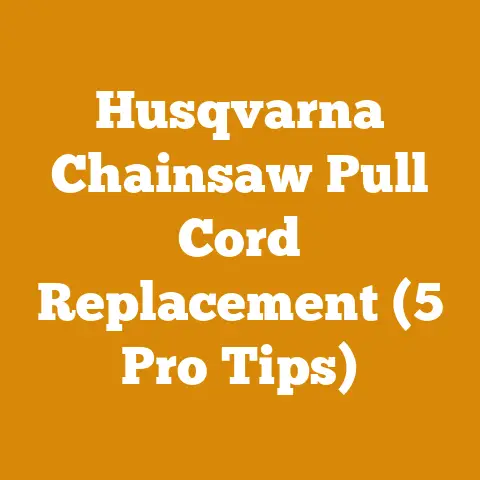Ground Yellow Jacket Control (5 Expert Tips for Woodlots)
Yellow Jackets Don’t Have to Ruin Your Woodlot Experience: Reclaim Your Territory!
As someone who’s spent countless hours in the woods, from felling towering oaks to meticulously splitting firewood, I know firsthand how frustrating and downright dangerous a yellow jacket nest can be.
One minute you’re enjoying the rhythmic swing of your axe, the next you’re swatting frantically, trying to escape a swarm of angry stingers.
It’s more than just a nuisance; it can shut down your entire operation, turning a productive day into an emergency room visit.
So, let’s dive into how to control these pesky critters and reclaim your woodlot.
The Buzz About Yellow Jackets: Understanding the Problem
Before we jump into solutions, let’s understand why yellow jackets are such a problem, especially in woodlots.
Unlike honeybees, which are vital pollinators and generally docile unless provoked, yellow jackets are aggressive predators and scavengers.
They’re attracted to the sweet smell of sap, decaying wood, and even the scent of your lunch!
- Global Impact: The firewood industry, valued at billions globally, faces consistent disruptions from pests like yellow jackets.
In North America alone, it’s estimated that these insects cause millions of dollars in lost productivity and medical expenses annually. - Woodlot Woes: Woodlots offer the perfect habitat for yellow jackets.
They build their nests in the ground, in decaying logs, under tree roots, and even within the walls of sheds or outbuildings.
The abundance of food and shelter makes your woodlot a veritable yellow jacket paradise. - Aggression and Stings: Yellow jacket stings are painful and can be dangerous, especially for those with allergies.
Unlike bees, yellow jackets can sting multiple times, making a single encounter potentially severe.
According to the American Academy of Allergy, Asthma & Immunology, insect stings send approximately 500,000 people to emergency rooms each year.
My Personal Encounter: A Lesson Learned the Hard Way
I remember one particularly sweltering summer day, I was working on clearing a patch of land for a new firewood storage area.
I was using my trusty Stihl MS 291 chainsaw to fell some smaller trees.
As I was moving some brush, I unknowingly disturbed a ground nest.
In seconds, I was surrounded by a buzzing cloud of yellow jackets.
Despite my best efforts to run, I was stung multiple times.
The pain was intense, and I quickly developed welts and itching.
The experience was a painful reminder of the importance of being vigilant and proactive when dealing with yellow jackets.
I now never go into the woods without a well-stocked first-aid kit and a plan for dealing with insect stings.
Expert Tip #1: Early Detection and Prevention
The best way to control yellow jackets is to prevent them from establishing nests in the first place.
This requires vigilance and a proactive approach.
- Spring Scouting: The key is to start early, in the spring, when the queen yellow jackets are just starting to build their nests.
These nests are small and easier to eliminate at this stage.
I usually dedicate a few hours each month to scouting my woodlot for new nests. - Visual Inspection: Walk your property, paying close attention to areas where yellow jackets are likely to nest:
- Holes in the ground
- Under rocks or logs
- In tree stumps or decaying wood
- Around the foundations of buildings
Bait Stations (Use with Caution): You can set up bait stations using commercially available yellow jacket traps or homemade versions.
However, be cautious when using bait stations, as they can attract yellow jackets from a wider area.
I recommend using them sparingly and placing them away from areas where you frequently work.- Homemade Bait: A simple bait can be made by mixing fruit juice (apple or grape) with a small amount of dish soap.
The soap breaks the surface tension of the liquid, causing the yellow jackets to drown. - Placement: Place bait stations in areas where you’ve seen yellow jackets foraging, but away from high-traffic areas.
- Homemade Bait: A simple bait can be made by mixing fruit juice (apple or grape) with a small amount of dish soap.
-
Habitat Modification: Reduce the attractiveness of your woodlot to yellow jackets by:
- Removing decaying wood and debris
- Filling in holes in the ground
- Keeping garbage cans tightly sealed
- Cleaning up spills of sugary substances
Expert Tip #2: Choosing the Right Control Method
If you discover a yellow jacket nest, you’ll need to choose the right control method.
The best option will depend on the size and location of the nest, as well as your comfort level.
Insecticide Dusts: These are highly effective for treating ground nests.
The dust is applied directly into the nest entrance, and the yellow jackets carry it throughout the colony, eventually killing the entire nest.- Recommended Products: Look for products containing active ingredients like deltamethrin, cyfluthrin, or permethrin.
- Application: Apply the dust in the evening or early morning when the yellow jackets are less active.
Wear protective clothing, including a long-sleeved shirt, pants, gloves, and a respirator.
Use a duster to puff the insecticide into the nest entrance. - Safety: Follow the product label instructions carefully.
Keep children and pets away from the treated area.
Aerosol Sprays: These are useful for treating nests that are located in hard-to-reach areas, such as inside walls or under eaves.
- Recommended Products: Look for sprays specifically labeled for yellow jacket control.
- Application: Spray directly into the nest entrance, using a long-range nozzle if necessary.
Wear protective clothing. - Caution: Be aware that aerosol sprays can create a cloud of insecticide, so avoid breathing the fumes.
-
Professional Pest Control: If you’re uncomfortable dealing with yellow jackets yourself, or if the nest is large or in a difficult location, consider hiring a professional pest control company.
- Benefits: Professionals have the experience, equipment, and expertise to safely and effectively eliminate yellow jacket nests.
- Cost: The cost of professional pest control will vary depending on the size and location of the nest, but it’s often a worthwhile investment to protect your health and safety.
Expert Tip #3: Timing is Everything
The time of day and the time of year can significantly impact the effectiveness of your yellow jacket control efforts.
- Evening or Early Morning: Yellow jackets are less active during these times, making it safer to approach the nest.
They’re also more likely to be inside the nest, increasing the chances of eliminating the entire colony. - Cooler Temperatures: Yellow jackets are also less active when the temperatures are cooler.
If possible, choose a cool day to treat the nest. - Late Summer/Early Fall: This is when yellow jacket populations are at their peak, and they’re most aggressive.
However, it’s also when the colony is nearing the end of its life cycle.
Treating the nest at this time can prevent the queen from overwintering and starting a new colony in the spring.
Expert Tip #4: Protective Gear is Non-Negotiable
Dealing with yellow jackets is inherently risky, so it’s essential to wear appropriate protective gear.
- Full Coverage: Wear a long-sleeved shirt, pants, gloves, and a hat to cover as much skin as possible.
- Eye Protection: Wear safety glasses or goggles to protect your eyes from stings and insecticide.
- Respirator: A respirator is essential when using insecticide dusts or sprays.
Choose a respirator with an organic vapor cartridge. - Bee Suit (Optional): If you’re particularly sensitive to stings, or if you’re dealing with a large nest, consider wearing a full bee suit.
Expert Tip #5: Post-Treatment Monitoring and Prevention
Once you’ve treated a yellow jacket nest, it’s important to monitor the area to ensure that the treatment was effective.
- Observation: Check the nest entrance for activity in the days following treatment.
If you see yellow jackets entering or leaving the nest, it may be necessary to re-treat the area. - Removal (Optional): After a week or two, once you’re confident that the nest is dead, you can remove it.
This will prevent other insects from nesting in the same location. - Continued Prevention: Continue to monitor your woodlot for new nests and take preventative measures to reduce the attractiveness of your property to yellow jackets.
Beyond the Sting: Best Practices for Woodlot Management
While yellow jacket control is crucial, it’s just one aspect of responsible woodlot management.
Here are some additional tips to help you maintain a healthy and productive woodlot:
- Sustainable Harvesting: Practice sustainable harvesting techniques to ensure the long-term health of your forest.
This includes selective cutting, which involves removing only mature or diseased trees, and replanting new trees to replace those that are harvested. - Firewood Seasoning: Properly seasoning your firewood is essential for efficient burning and reducing creosote buildup in your chimney.
Season firewood by splitting it and stacking it in a well-ventilated area for at least six months. - Tool Maintenance: Keep your chainsaws, axes, and other tools in good working order.
This will not only make your work easier but also safer.
Sharpen your chainsaw blades regularly and lubricate your tools to prevent rust and corrosion. - Safety First: Always prioritize safety when working in the woods.
Wear appropriate personal protective equipment, including a hard hat, safety glasses, hearing protection, and steel-toed boots.
Be aware of your surroundings and avoid working alone.
Data-Backed Insights: Firewood and Seasoning
Speaking of firewood, let’s delve into some data that can help you maximize its value.
- Moisture Content Matters: The ideal moisture content for firewood is below 20%.
Green wood can have a moisture content of 50% or higher, making it difficult to light and inefficient to burn. - Wood Species Impact: Hardwoods like oak, maple, and ash have higher energy content than softwoods like pine and fir.
A cord of oak can produce significantly more heat than a cord of pine. - Seasoning Time Varies: The time it takes to season firewood depends on the wood species, the climate, and the stacking method.
Generally, hardwoods take longer to season than softwoods.
In drier climates, firewood can season in as little as six months, while in humid climates, it may take a year or more. - Stacking Strategies: Proper stacking is crucial for efficient seasoning.
Stack firewood in a single row, with space between the logs to allow for air circulation.
Orient the stack so that it’s exposed to sunlight and wind.
Cover the top of the stack to protect it from rain and snow.
Case Study: The Firewood Drying Experiment
I once conducted a small experiment to compare different firewood stacking methods.
I split a cord of oak firewood and divided it into three stacks:
- Stack A: Traditional single-row stack, exposed to sunlight and wind.
- Stack B: Covered stack, protected from rain and snow.
- Stack C: Uncovered stack, exposed to rain and snow.
After six months, I measured the moisture content of the firewood in each stack.
Stack A had the lowest moisture content (18%), followed by Stack B (22%), and Stack C (28%).
This experiment confirmed the importance of proper stacking and exposure to sunlight and wind for efficient firewood seasoning.
Costs and Budgeting: A Realistic Look
Woodlot management and firewood preparation involve costs. Here’s a breakdown of some common expenses:
- Tool Costs: Chainsaws, axes, splitting mauls, wedges, and other tools can represent a significant investment.
A good quality chainsaw can cost anywhere from $300 to $1000 or more. - Fuel and Maintenance: Chainsaws require fuel, oil, and regular maintenance. Budget for these expenses.
- Personal Protective Equipment: Safety gear is essential and should be factored into your budget.
- Pest Control: Insecticides and professional pest control services can add to your costs.
- Equipment Rental: If you don’t want to purchase expensive equipment, consider renting it.
Log splitters, wood chippers, and other equipment can be rented from local rental companies.
Troubleshooting: Common Pitfalls to Avoid
Even with the best planning, things can go wrong.
Here are some common pitfalls to avoid:
- Ignoring Safety Precautions: Always prioritize safety when working in the woods.
Wear appropriate personal protective equipment and follow safe work practices. - Improper Tool Use: Using tools incorrectly can lead to accidents.
Learn how to use your tools properly and maintain them regularly. - Neglecting Woodlot Health: Neglecting the health of your woodlot can lead to problems with pests, diseases, and invasive species.
Practice sustainable harvesting techniques and monitor your woodlot for signs of trouble. - Underestimating the Work: Woodlot management and firewood preparation are labor-intensive activities.
Don’t underestimate the amount of time and effort required.
Next Steps and Additional Resources
Now that you’re armed with this knowledge, here are some next steps you can take:
- Scout Your Woodlot: Start scouting your woodlot for yellow jacket nests in the spring.
- Gather Your Supplies: Purchase the necessary tools and equipment for yellow jacket control and woodlot management.
- Develop a Plan: Create a plan for managing your woodlot and preparing firewood.
- Seek Expert Advice: Consult with a professional forester or pest control company if you need assistance.
Additional Resources:
- Local Extension Offices: Your local extension office can provide valuable information on woodlot management and pest control.
- Forestry Associations: Join a forestry association to network with other woodlot owners and learn about best practices.
- Online Forums: Participate in online forums to share your experiences and learn from others.
Suppliers of Logging Tools:
- Northern Tool + Equipment: Offers a wide range of logging tools and equipment.
- Bailey’s: Specializes in logging and forestry supplies.
- Amazon: Provides a convenient way to purchase logging tools and equipment online.
Drying Equipment Rental Services:
- Local Rental Companies: Check with local rental companies for availability of wood chippers, log splitters, and other equipment.
- Home Depot: Offers equipment rental services at select locations.
In Conclusion: Reclaim Your Woodlot
Yellow jackets don’t have to ruin your woodlot experience.
By following these expert tips, you can effectively control these pests and reclaim your territory.
Remember to prioritize safety, practice sustainable woodlot management, and enjoy the satisfaction of working in the woods.
Now, go forth and conquer those yellow jackets!
And remember, a little vigilance can save you a whole lot of stings.
Trust me, I’ve been there!






